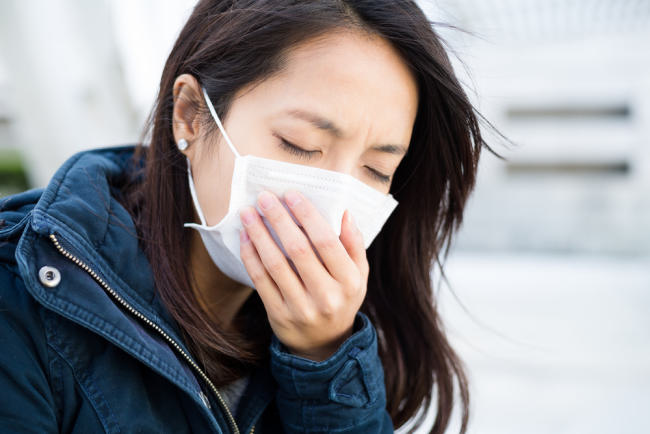Aspergillosis is an infectious disease caused by a fungus Aspergillus. This infectious disease generally affects the respiratory system, but can also spread to other parts of the body, such as the skin, eyes,or brain.
Mold Aspergillus live in soil, trees, rice, dry leaves, compost, air conditioners and heaters, or damp places. fungal infection Aspergillus It is more common in people with weakened immune systems.

Causes of Aspergillosis
Aspergillosis is caused by a fungus Aspergillus which is inhaled into the respiratory tract. Among the many types of mushrooms Aspergillus, aspergillosis is most often caused by Aspergillusfumigatus or A.fumigatus. There are several factors that can increase a person's risk of developing aspergillosis, namely:
- Have a weakened immune system due to HIV/AIDS, blood cancer, or using immunosuppressant drugs, corticosteroids, and chemotherapy
- Undergoing an organ transplant or bone marrow transplant
- Have a lung disease, such as asthma, COPD, tuberculosis (TB), sarcoidosis, or cystic fibrosis
Symptoms of Aspergillosis
In healthy people with a good immune system, inhalation of mushrooms Aspergillus will not cause complaints and symptoms. However, if a person has a weakened immune system or has the previously mentioned risk factors, inhale it Aspergillus will cause various complaints and symptoms.
Symptoms and complaints that appear depend on the type of organ or body tissue that is attacked by the fungus Aspergillus. The following are the symptoms and types of aspergillosis that often occur:
Allergic bronchopulmonary aspergillosis (ABPA)
ABPA is most common in people with asthma or cystic fibrosis. This condition is an allergic reaction due to exposure to mold Aspergillus. Complaints similar to asthma symptoms, namely wheezing, difficulty breathing, shortness of breath, and weakness.
Chronic pulmonary aspergillosis (CPA)
This type of aspergillosis usually occurs in people who have lung diseases, such as tuberculosis, COPD, or sarcoidosis. CPA is generally characterized by weight loss, coughing or coughing up blood, fatigue, and shortness of breath. People with CPA can also experience aspergilloma, which is a fungal fiber that grows and forms a mushroom ball.
Invasive pulmonary aspergillosis(IPA)
Invasive pulmonary aspergillosis or IPA usually occurs in people with weakened immune systems, for example in people with HIV, people undergoing chemotherapy, or people who have had a bone marrow transplant.
IPA is the most severe type of aspergillosis. This condition occurs when the infection spreads to the skin, kidneys, lungs, brain, or heart. Symptoms of this type of aspergillosis depend on the organ affected. However, in general, the symptoms are as follows:
- Fever and chills
- Bleeding cough
- Chest pain
- Hard to breathe
- Headache
When to go to the doctor
Check with a doctor if you experience the symptoms of aspergillosis above. People with asthma or cystic fibrosis Those who experience respiratory problems should also immediately see a doctor for treatment.
If you have a weak immune system, then you have a fever, coughing up blood, and shortness of breath, go to the emergency room immediately for help. You may have invasive aspergillosis, which needs to be treated quickly.
Diagnosis of Aspergillosis
The doctor will ask the patient's complaints and medical history, then the doctor will perform a physical examination to hear the patient's breath sounds. In this way, the doctor can detect whether there is a disturbance in the patient's airway.
Aspergillosis is difficult to diagnose, so it is necessary to carry out investigations to determine the cause. The follow-up examinations include:
- Scanning with X-rays or CT scans, to see the presence of fungal balls (aspergilloma), while looking for signs of infection in the lungs
- Sputum test, to check for presence Aspergillus or other microorganisms that can cause infection
- Blood test, to measure antibody levels in the blood as an indication of an allergic reaction and to detect signs of infection
- Bronchoscopy, to examine the condition of the lungs as well as take a tissue sample (biopsy) for further investigation
Aspergillosis Treatment
Aspergillosis treatment varies, depending on the severity and type of aspergillosis suffered. Some of the treatment steps that doctors can take are:
- Observation, to monitor the condition of patients with mild symptoms or in patients with aspergillosis who have aspergilloma in the lungs
- Administration of antifungal drugs, such as voriconazole or amphotericin B, especially for patients with IPA and CPA
- Administration of corticosteroids and antifungal drugs for several months, to treat the symptoms of ABPA
- Administration of oral corticosteroid drugs, to prevent asthma or cystic fibrosis suffered by the patient did not get worse
- Operation, to lift aspergilloma from within the body, especially when aspergilloma causes bleeding in the lungs
- Embolization, to stop bleeding caused by aspergilloma
Complications of Aspergillosis
If left untreated or treated too late, aspergillosis can cause complications such as:
- Systemic infection or sepsis that spreads rapidly to other parts of the body, such as the brain, heart, and kidneys
- Severe bleeding in the lungs, especially in patients with aspergilloma and invasive aspergillosis
- Atelectasis
- Asthma can get worse
- Bronchiectasis and pulmonary fibrosis
Aspergillosis Prevention
Aspergillosis is difficult to prevent because the fungus that causes this condition is easily inhaled. However, the following things can be done to reduce the risk of developing aspergillosis, especially for people with weakened immune systems:
- Avoid places that are prone to mold growth, such as burrows, rice or wheat storage areas, and compost piles.
- Use a mask and covered clothes when doing activities in places that are at risk of being exposed to mold, such as in gardens, rice fields, or forests.
- Use gloves when doing activities that require you to come into direct contact with soil, feces, or moss.
- Do not dry wet clothes in the house, especially in the bedroom.









